Marketing Strategy and Plan: Second Cup Coffee's New Product Launch
VerifiedAdded on 2020/03/16
|21
|4825
|431
Report
AI Summary
This report provides a comprehensive marketing strategy and plan for Second Cup Coffee, focusing on the launch of their new product, Caffetine. The report begins with an executive summary highlighting the core problem of declining sales and the introduction of Caffetine as a solution. It includes a detailed SWOT analysis, exploring the company's strengths (new product, infrastructure improvements), weaknesses (lack of product diversification), opportunities (growing coffee consumption), and threats (competition). The report then evaluates alternative marketing approaches and recommends the launch of Caffetine, emphasizing its potential to attract customers and increase profitability. Corporate and marketing objectives are outlined, followed by a target market profile, positioning strategy, and a marketing mix. The report concludes with a marketing budget, time schedule, and overall conclusion, providing a structured approach to Second Cup's marketing initiatives.
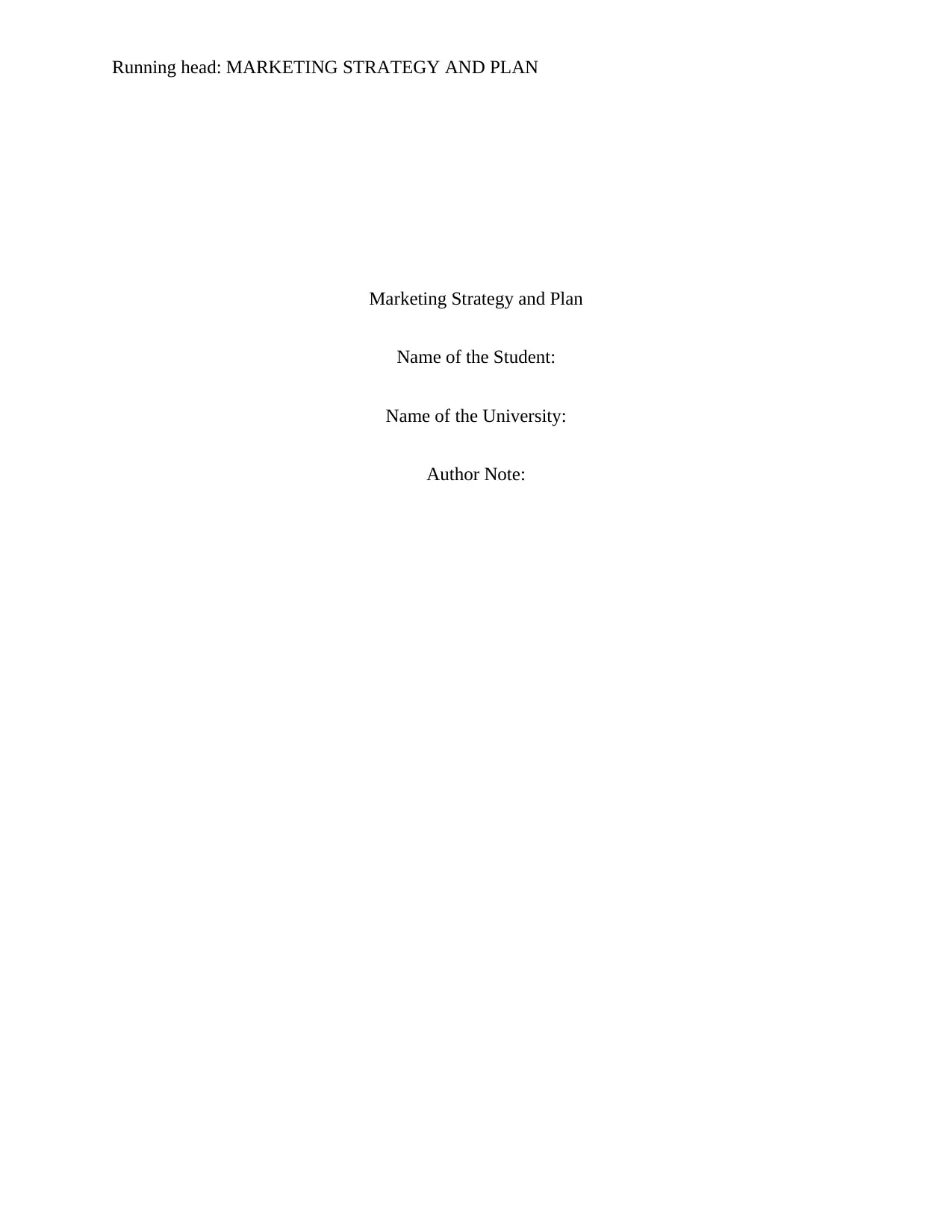
Running head: MARKETING STRATEGY AND PLAN
Marketing Strategy and Plan
Name of the Student:
Name of the University:
Author Note:
Marketing Strategy and Plan
Name of the Student:
Name of the University:
Author Note:
Paraphrase This Document
Need a fresh take? Get an instant paraphrase of this document with our AI Paraphraser
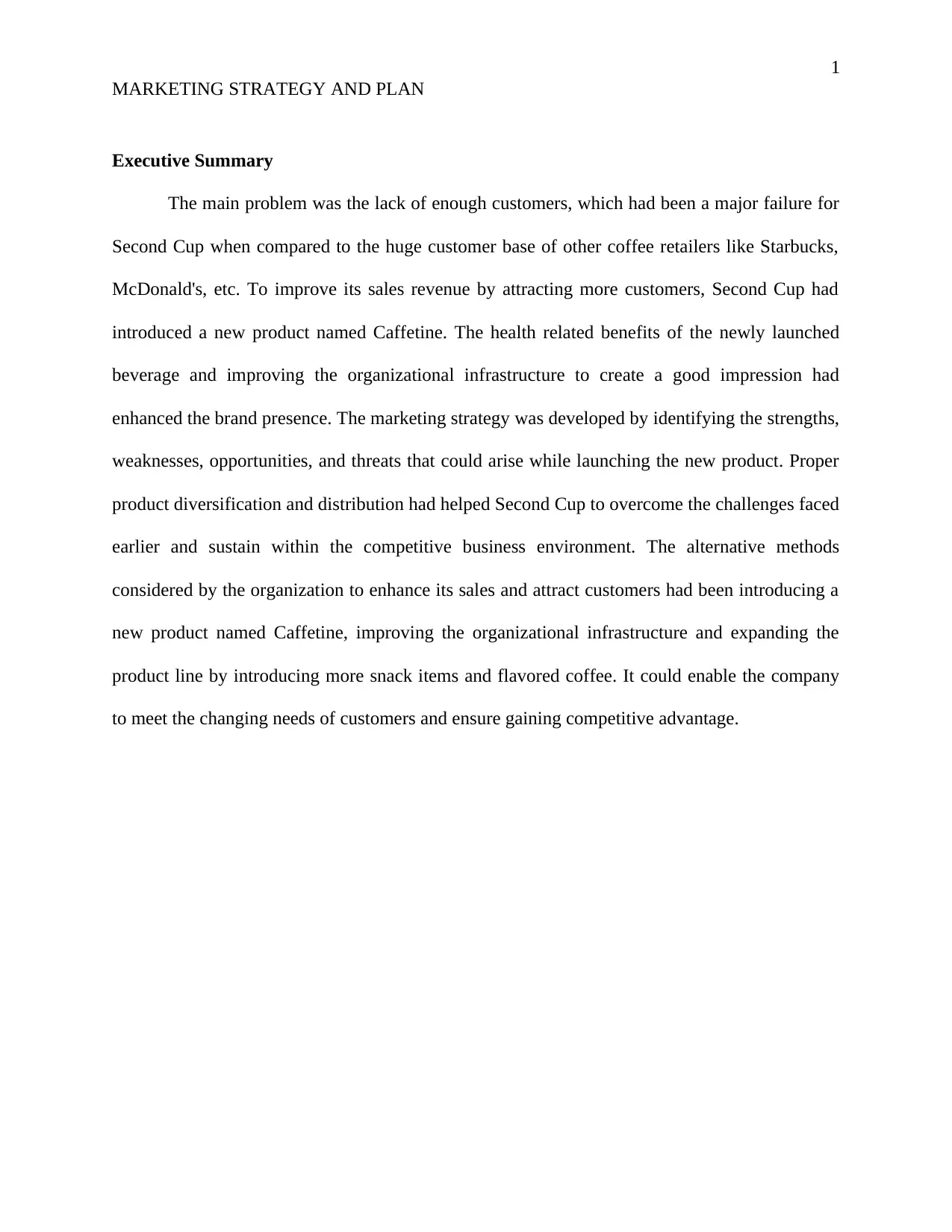
1
MARKETING STRATEGY AND PLAN
Executive Summary
The main problem was the lack of enough customers, which had been a major failure for
Second Cup when compared to the huge customer base of other coffee retailers like Starbucks,
McDonald's, etc. To improve its sales revenue by attracting more customers, Second Cup had
introduced a new product named Caffetine. The health related benefits of the newly launched
beverage and improving the organizational infrastructure to create a good impression had
enhanced the brand presence. The marketing strategy was developed by identifying the strengths,
weaknesses, opportunities, and threats that could arise while launching the new product. Proper
product diversification and distribution had helped Second Cup to overcome the challenges faced
earlier and sustain within the competitive business environment. The alternative methods
considered by the organization to enhance its sales and attract customers had been introducing a
new product named Caffetine, improving the organizational infrastructure and expanding the
product line by introducing more snack items and flavored coffee. It could enable the company
to meet the changing needs of customers and ensure gaining competitive advantage.
MARKETING STRATEGY AND PLAN
Executive Summary
The main problem was the lack of enough customers, which had been a major failure for
Second Cup when compared to the huge customer base of other coffee retailers like Starbucks,
McDonald's, etc. To improve its sales revenue by attracting more customers, Second Cup had
introduced a new product named Caffetine. The health related benefits of the newly launched
beverage and improving the organizational infrastructure to create a good impression had
enhanced the brand presence. The marketing strategy was developed by identifying the strengths,
weaknesses, opportunities, and threats that could arise while launching the new product. Proper
product diversification and distribution had helped Second Cup to overcome the challenges faced
earlier and sustain within the competitive business environment. The alternative methods
considered by the organization to enhance its sales and attract customers had been introducing a
new product named Caffetine, improving the organizational infrastructure and expanding the
product line by introducing more snack items and flavored coffee. It could enable the company
to meet the changing needs of customers and ensure gaining competitive advantage.
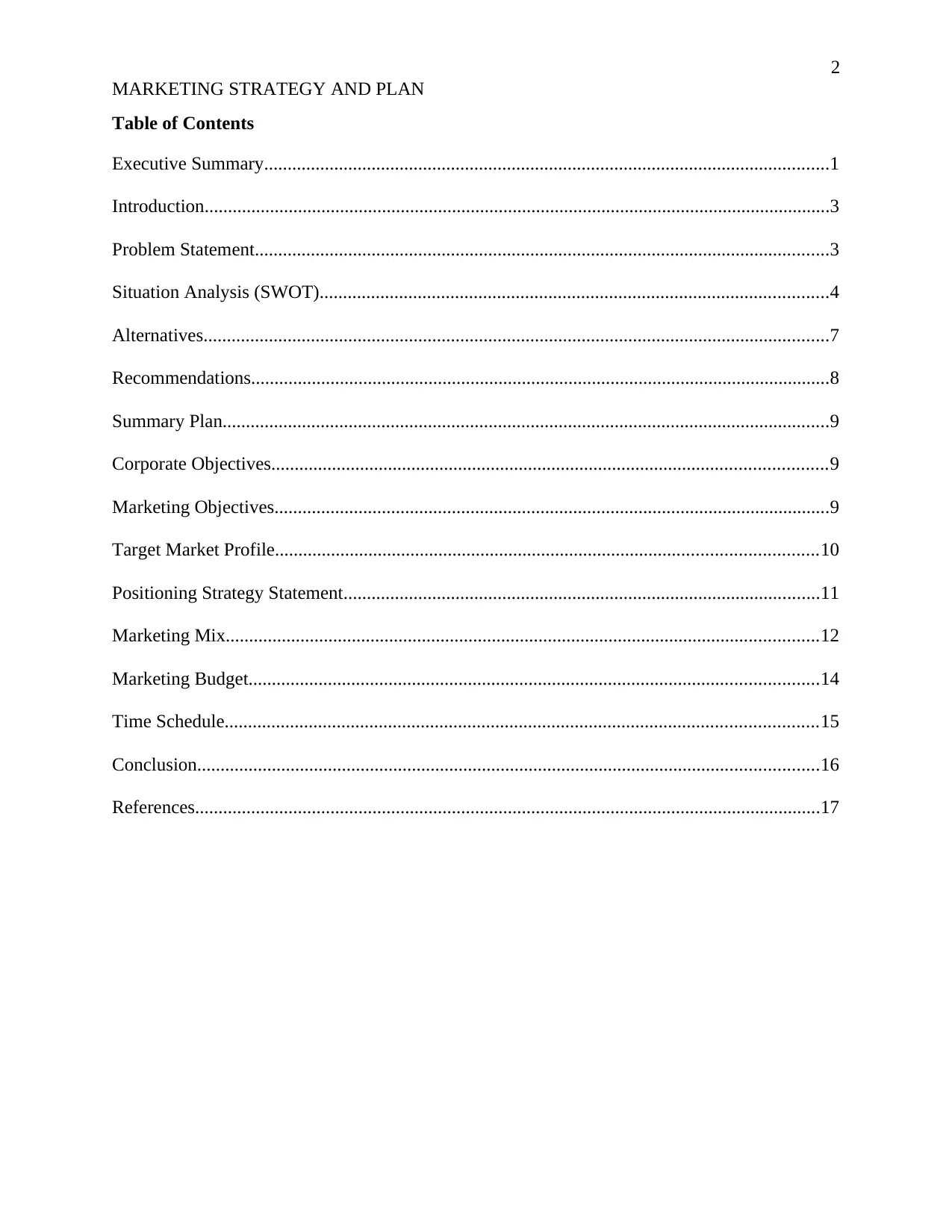
2
MARKETING STRATEGY AND PLAN
Table of Contents
Executive Summary.........................................................................................................................1
Introduction......................................................................................................................................3
Problem Statement...........................................................................................................................3
Situation Analysis (SWOT).............................................................................................................4
Alternatives......................................................................................................................................7
Recommendations............................................................................................................................8
Summary Plan..................................................................................................................................9
Corporate Objectives.......................................................................................................................9
Marketing Objectives.......................................................................................................................9
Target Market Profile....................................................................................................................10
Positioning Strategy Statement......................................................................................................11
Marketing Mix...............................................................................................................................12
Marketing Budget..........................................................................................................................14
Time Schedule...............................................................................................................................15
Conclusion.....................................................................................................................................16
References......................................................................................................................................17
MARKETING STRATEGY AND PLAN
Table of Contents
Executive Summary.........................................................................................................................1
Introduction......................................................................................................................................3
Problem Statement...........................................................................................................................3
Situation Analysis (SWOT).............................................................................................................4
Alternatives......................................................................................................................................7
Recommendations............................................................................................................................8
Summary Plan..................................................................................................................................9
Corporate Objectives.......................................................................................................................9
Marketing Objectives.......................................................................................................................9
Target Market Profile....................................................................................................................10
Positioning Strategy Statement......................................................................................................11
Marketing Mix...............................................................................................................................12
Marketing Budget..........................................................................................................................14
Time Schedule...............................................................................................................................15
Conclusion.....................................................................................................................................16
References......................................................................................................................................17
⊘ This is a preview!⊘
Do you want full access?
Subscribe today to unlock all pages.

Trusted by 1+ million students worldwide
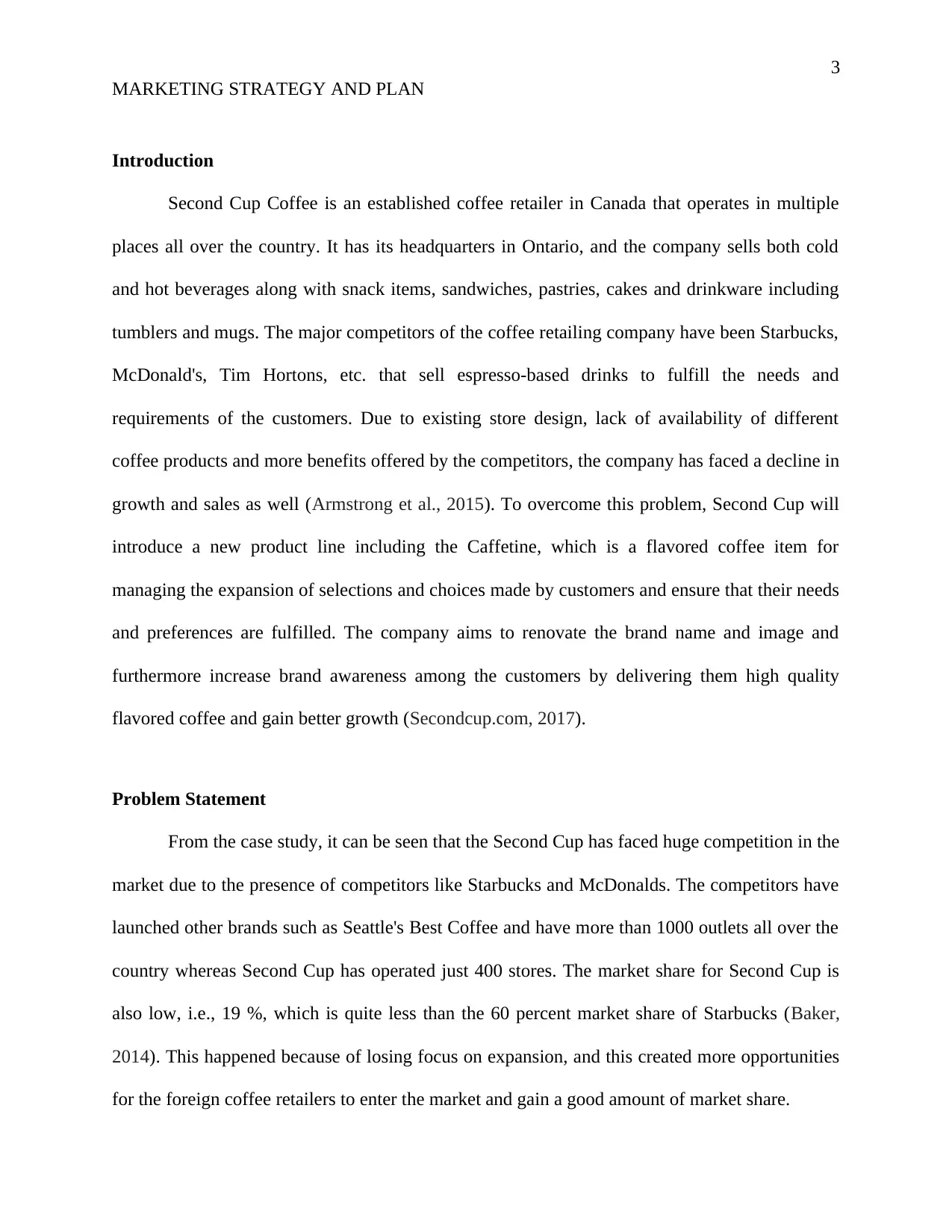
3
MARKETING STRATEGY AND PLAN
Introduction
Second Cup Coffee is an established coffee retailer in Canada that operates in multiple
places all over the country. It has its headquarters in Ontario, and the company sells both cold
and hot beverages along with snack items, sandwiches, pastries, cakes and drinkware including
tumblers and mugs. The major competitors of the coffee retailing company have been Starbucks,
McDonald's, Tim Hortons, etc. that sell espresso-based drinks to fulfill the needs and
requirements of the customers. Due to existing store design, lack of availability of different
coffee products and more benefits offered by the competitors, the company has faced a decline in
growth and sales as well (Armstrong et al., 2015). To overcome this problem, Second Cup will
introduce a new product line including the Caffetine, which is a flavored coffee item for
managing the expansion of selections and choices made by customers and ensure that their needs
and preferences are fulfilled. The company aims to renovate the brand name and image and
furthermore increase brand awareness among the customers by delivering them high quality
flavored coffee and gain better growth (Secondcup.com, 2017).
Problem Statement
From the case study, it can be seen that the Second Cup has faced huge competition in the
market due to the presence of competitors like Starbucks and McDonalds. The competitors have
launched other brands such as Seattle's Best Coffee and have more than 1000 outlets all over the
country whereas Second Cup has operated just 400 stores. The market share for Second Cup is
also low, i.e., 19 %, which is quite less than the 60 percent market share of Starbucks (Baker,
2014). This happened because of losing focus on expansion, and this created more opportunities
for the foreign coffee retailers to enter the market and gain a good amount of market share.
MARKETING STRATEGY AND PLAN
Introduction
Second Cup Coffee is an established coffee retailer in Canada that operates in multiple
places all over the country. It has its headquarters in Ontario, and the company sells both cold
and hot beverages along with snack items, sandwiches, pastries, cakes and drinkware including
tumblers and mugs. The major competitors of the coffee retailing company have been Starbucks,
McDonald's, Tim Hortons, etc. that sell espresso-based drinks to fulfill the needs and
requirements of the customers. Due to existing store design, lack of availability of different
coffee products and more benefits offered by the competitors, the company has faced a decline in
growth and sales as well (Armstrong et al., 2015). To overcome this problem, Second Cup will
introduce a new product line including the Caffetine, which is a flavored coffee item for
managing the expansion of selections and choices made by customers and ensure that their needs
and preferences are fulfilled. The company aims to renovate the brand name and image and
furthermore increase brand awareness among the customers by delivering them high quality
flavored coffee and gain better growth (Secondcup.com, 2017).
Problem Statement
From the case study, it can be seen that the Second Cup has faced huge competition in the
market due to the presence of competitors like Starbucks and McDonalds. The competitors have
launched other brands such as Seattle's Best Coffee and have more than 1000 outlets all over the
country whereas Second Cup has operated just 400 stores. The market share for Second Cup is
also low, i.e., 19 %, which is quite less than the 60 percent market share of Starbucks (Baker,
2014). This happened because of losing focus on expansion, and this created more opportunities
for the foreign coffee retailers to enter the market and gain a good amount of market share.
Paraphrase This Document
Need a fresh take? Get an instant paraphrase of this document with our AI Paraphraser
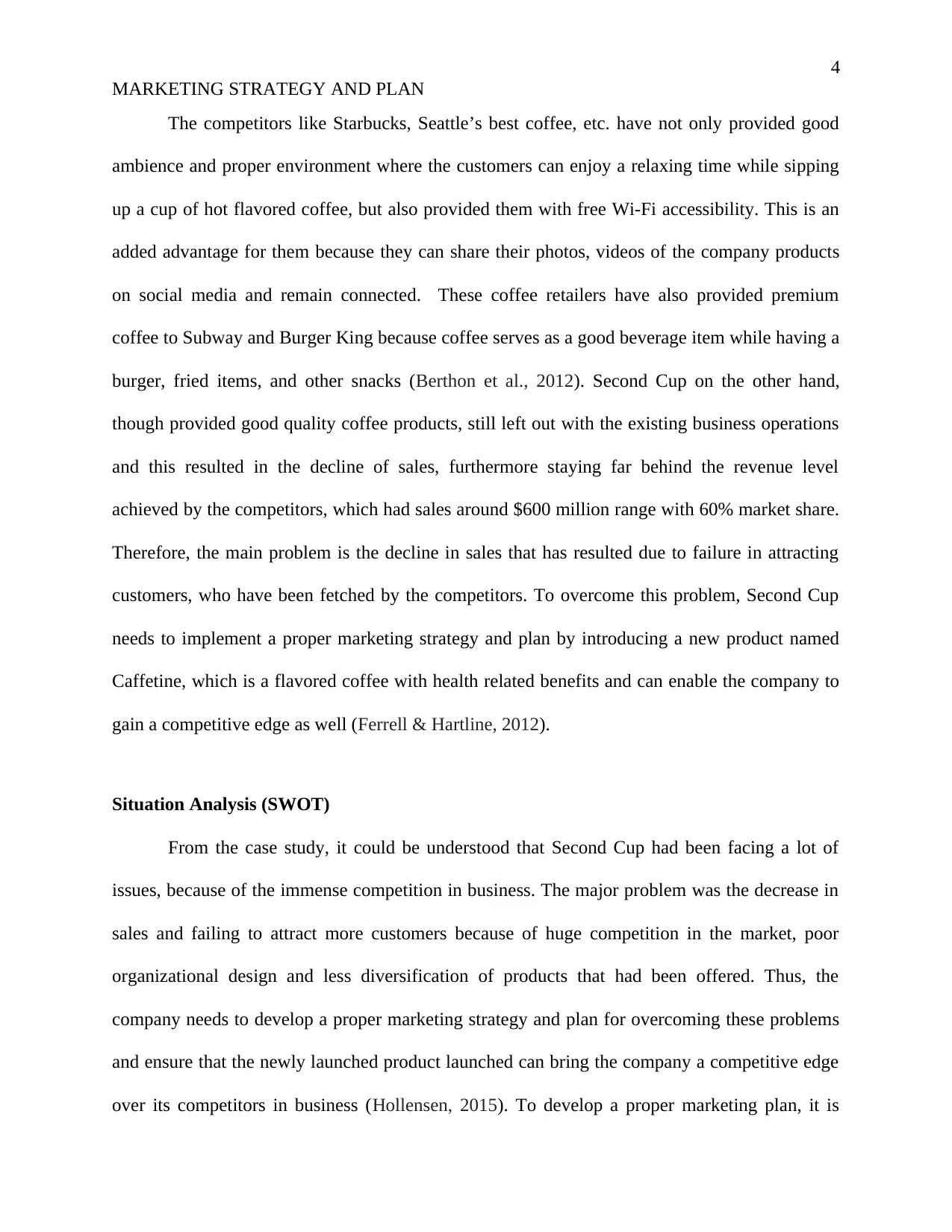
4
MARKETING STRATEGY AND PLAN
The competitors like Starbucks, Seattle’s best coffee, etc. have not only provided good
ambience and proper environment where the customers can enjoy a relaxing time while sipping
up a cup of hot flavored coffee, but also provided them with free Wi-Fi accessibility. This is an
added advantage for them because they can share their photos, videos of the company products
on social media and remain connected. These coffee retailers have also provided premium
coffee to Subway and Burger King because coffee serves as a good beverage item while having a
burger, fried items, and other snacks (Berthon et al., 2012). Second Cup on the other hand,
though provided good quality coffee products, still left out with the existing business operations
and this resulted in the decline of sales, furthermore staying far behind the revenue level
achieved by the competitors, which had sales around $600 million range with 60% market share.
Therefore, the main problem is the decline in sales that has resulted due to failure in attracting
customers, who have been fetched by the competitors. To overcome this problem, Second Cup
needs to implement a proper marketing strategy and plan by introducing a new product named
Caffetine, which is a flavored coffee with health related benefits and can enable the company to
gain a competitive edge as well (Ferrell & Hartline, 2012).
Situation Analysis (SWOT)
From the case study, it could be understood that Second Cup had been facing a lot of
issues, because of the immense competition in business. The major problem was the decrease in
sales and failing to attract more customers because of huge competition in the market, poor
organizational design and less diversification of products that had been offered. Thus, the
company needs to develop a proper marketing strategy and plan for overcoming these problems
and ensure that the newly launched product launched can bring the company a competitive edge
over its competitors in business (Hollensen, 2015). To develop a proper marketing plan, it is
MARKETING STRATEGY AND PLAN
The competitors like Starbucks, Seattle’s best coffee, etc. have not only provided good
ambience and proper environment where the customers can enjoy a relaxing time while sipping
up a cup of hot flavored coffee, but also provided them with free Wi-Fi accessibility. This is an
added advantage for them because they can share their photos, videos of the company products
on social media and remain connected. These coffee retailers have also provided premium
coffee to Subway and Burger King because coffee serves as a good beverage item while having a
burger, fried items, and other snacks (Berthon et al., 2012). Second Cup on the other hand,
though provided good quality coffee products, still left out with the existing business operations
and this resulted in the decline of sales, furthermore staying far behind the revenue level
achieved by the competitors, which had sales around $600 million range with 60% market share.
Therefore, the main problem is the decline in sales that has resulted due to failure in attracting
customers, who have been fetched by the competitors. To overcome this problem, Second Cup
needs to implement a proper marketing strategy and plan by introducing a new product named
Caffetine, which is a flavored coffee with health related benefits and can enable the company to
gain a competitive edge as well (Ferrell & Hartline, 2012).
Situation Analysis (SWOT)
From the case study, it could be understood that Second Cup had been facing a lot of
issues, because of the immense competition in business. The major problem was the decrease in
sales and failing to attract more customers because of huge competition in the market, poor
organizational design and less diversification of products that had been offered. Thus, the
company needs to develop a proper marketing strategy and plan for overcoming these problems
and ensure that the newly launched product launched can bring the company a competitive edge
over its competitors in business (Hollensen, 2015). To develop a proper marketing plan, it is
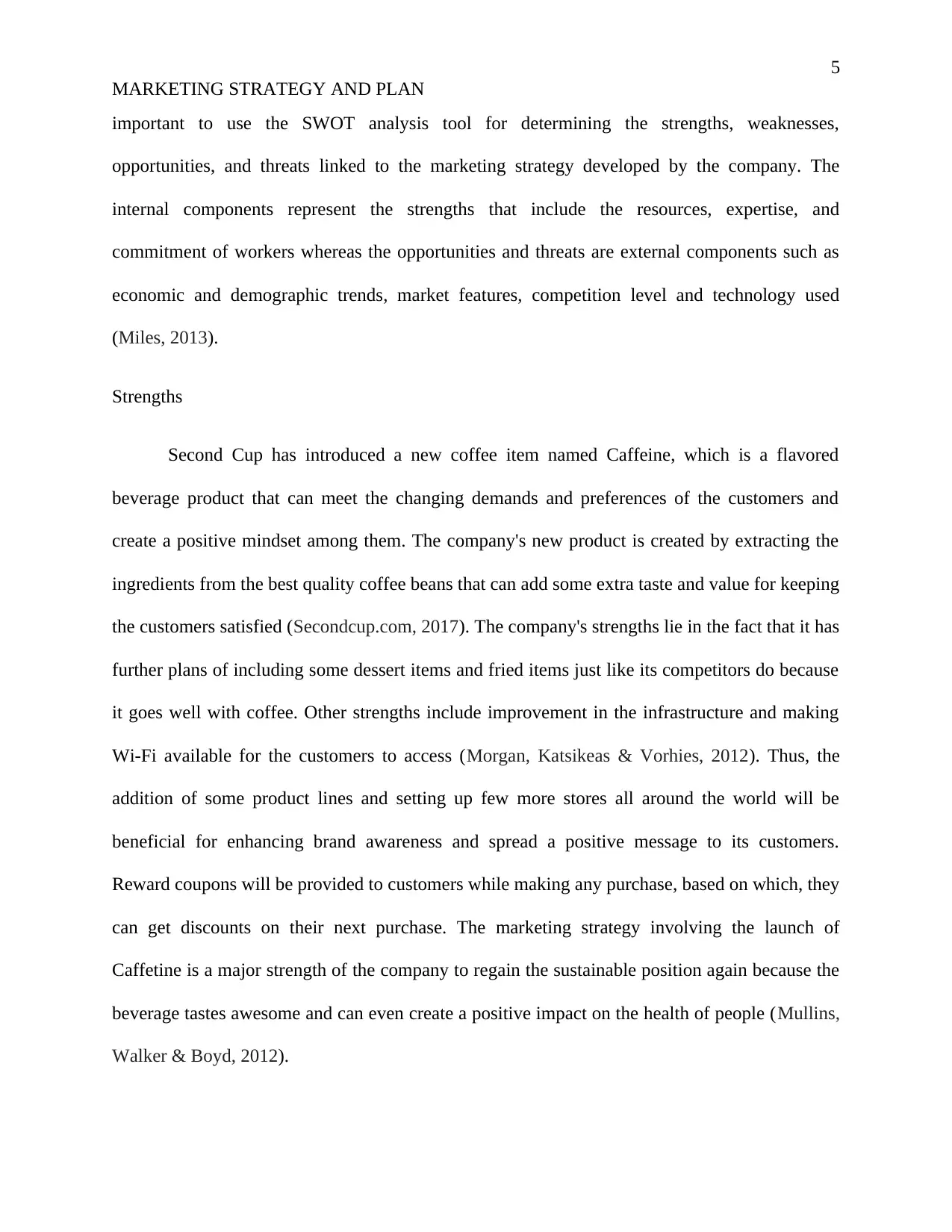
5
MARKETING STRATEGY AND PLAN
important to use the SWOT analysis tool for determining the strengths, weaknesses,
opportunities, and threats linked to the marketing strategy developed by the company. The
internal components represent the strengths that include the resources, expertise, and
commitment of workers whereas the opportunities and threats are external components such as
economic and demographic trends, market features, competition level and technology used
(Miles, 2013).
Strengths
Second Cup has introduced a new coffee item named Caffeine, which is a flavored
beverage product that can meet the changing demands and preferences of the customers and
create a positive mindset among them. The company's new product is created by extracting the
ingredients from the best quality coffee beans that can add some extra taste and value for keeping
the customers satisfied (Secondcup.com, 2017). The company's strengths lie in the fact that it has
further plans of including some dessert items and fried items just like its competitors do because
it goes well with coffee. Other strengths include improvement in the infrastructure and making
Wi-Fi available for the customers to access (Morgan, Katsikeas & Vorhies, 2012). Thus, the
addition of some product lines and setting up few more stores all around the world will be
beneficial for enhancing brand awareness and spread a positive message to its customers.
Reward coupons will be provided to customers while making any purchase, based on which, they
can get discounts on their next purchase. The marketing strategy involving the launch of
Caffetine is a major strength of the company to regain the sustainable position again because the
beverage tastes awesome and can even create a positive impact on the health of people (Mullins,
Walker & Boyd, 2012).
MARKETING STRATEGY AND PLAN
important to use the SWOT analysis tool for determining the strengths, weaknesses,
opportunities, and threats linked to the marketing strategy developed by the company. The
internal components represent the strengths that include the resources, expertise, and
commitment of workers whereas the opportunities and threats are external components such as
economic and demographic trends, market features, competition level and technology used
(Miles, 2013).
Strengths
Second Cup has introduced a new coffee item named Caffeine, which is a flavored
beverage product that can meet the changing demands and preferences of the customers and
create a positive mindset among them. The company's new product is created by extracting the
ingredients from the best quality coffee beans that can add some extra taste and value for keeping
the customers satisfied (Secondcup.com, 2017). The company's strengths lie in the fact that it has
further plans of including some dessert items and fried items just like its competitors do because
it goes well with coffee. Other strengths include improvement in the infrastructure and making
Wi-Fi available for the customers to access (Morgan, Katsikeas & Vorhies, 2012). Thus, the
addition of some product lines and setting up few more stores all around the world will be
beneficial for enhancing brand awareness and spread a positive message to its customers.
Reward coupons will be provided to customers while making any purchase, based on which, they
can get discounts on their next purchase. The marketing strategy involving the launch of
Caffetine is a major strength of the company to regain the sustainable position again because the
beverage tastes awesome and can even create a positive impact on the health of people (Mullins,
Walker & Boyd, 2012).
⊘ This is a preview!⊘
Do you want full access?
Subscribe today to unlock all pages.

Trusted by 1+ million students worldwide
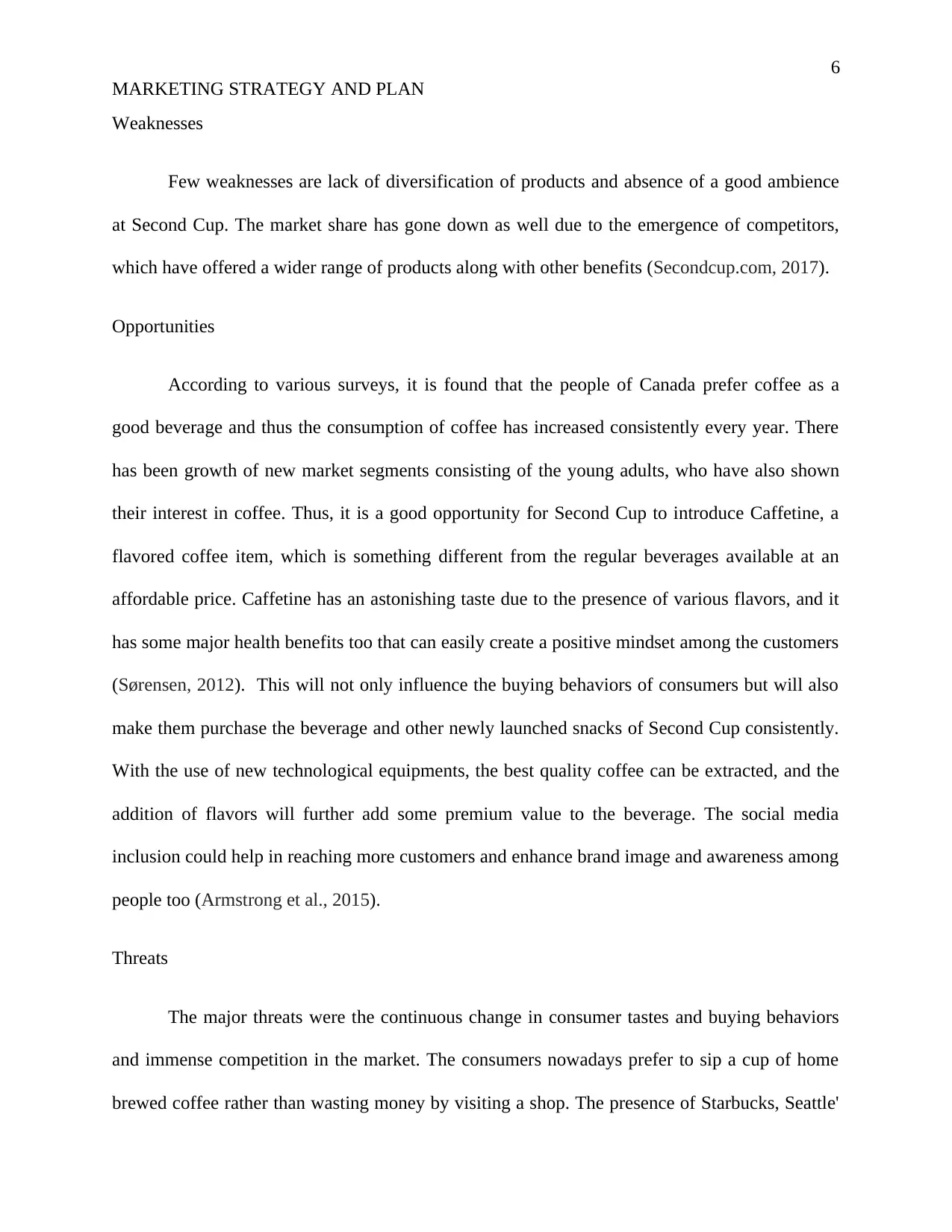
6
MARKETING STRATEGY AND PLAN
Weaknesses
Few weaknesses are lack of diversification of products and absence of a good ambience
at Second Cup. The market share has gone down as well due to the emergence of competitors,
which have offered a wider range of products along with other benefits (Secondcup.com, 2017).
Opportunities
According to various surveys, it is found that the people of Canada prefer coffee as a
good beverage and thus the consumption of coffee has increased consistently every year. There
has been growth of new market segments consisting of the young adults, who have also shown
their interest in coffee. Thus, it is a good opportunity for Second Cup to introduce Caffetine, a
flavored coffee item, which is something different from the regular beverages available at an
affordable price. Caffetine has an astonishing taste due to the presence of various flavors, and it
has some major health benefits too that can easily create a positive mindset among the customers
(Sørensen, 2012). This will not only influence the buying behaviors of consumers but will also
make them purchase the beverage and other newly launched snacks of Second Cup consistently.
With the use of new technological equipments, the best quality coffee can be extracted, and the
addition of flavors will further add some premium value to the beverage. The social media
inclusion could help in reaching more customers and enhance brand image and awareness among
people too (Armstrong et al., 2015).
Threats
The major threats were the continuous change in consumer tastes and buying behaviors
and immense competition in the market. The consumers nowadays prefer to sip a cup of home
brewed coffee rather than wasting money by visiting a shop. The presence of Starbucks, Seattle'
MARKETING STRATEGY AND PLAN
Weaknesses
Few weaknesses are lack of diversification of products and absence of a good ambience
at Second Cup. The market share has gone down as well due to the emergence of competitors,
which have offered a wider range of products along with other benefits (Secondcup.com, 2017).
Opportunities
According to various surveys, it is found that the people of Canada prefer coffee as a
good beverage and thus the consumption of coffee has increased consistently every year. There
has been growth of new market segments consisting of the young adults, who have also shown
their interest in coffee. Thus, it is a good opportunity for Second Cup to introduce Caffetine, a
flavored coffee item, which is something different from the regular beverages available at an
affordable price. Caffetine has an astonishing taste due to the presence of various flavors, and it
has some major health benefits too that can easily create a positive mindset among the customers
(Sørensen, 2012). This will not only influence the buying behaviors of consumers but will also
make them purchase the beverage and other newly launched snacks of Second Cup consistently.
With the use of new technological equipments, the best quality coffee can be extracted, and the
addition of flavors will further add some premium value to the beverage. The social media
inclusion could help in reaching more customers and enhance brand image and awareness among
people too (Armstrong et al., 2015).
Threats
The major threats were the continuous change in consumer tastes and buying behaviors
and immense competition in the market. The consumers nowadays prefer to sip a cup of home
brewed coffee rather than wasting money by visiting a shop. The presence of Starbucks, Seattle'
Paraphrase This Document
Need a fresh take? Get an instant paraphrase of this document with our AI Paraphraser
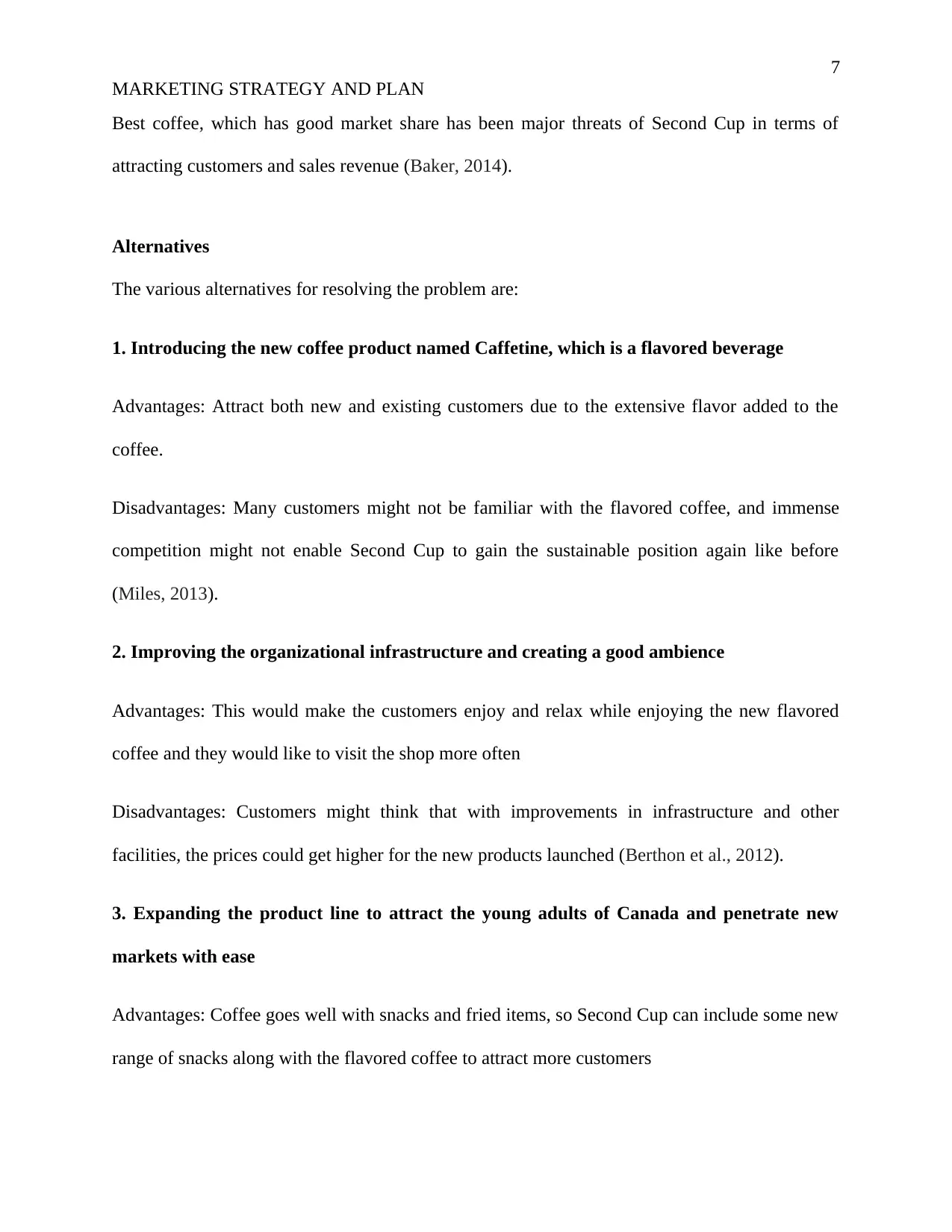
7
MARKETING STRATEGY AND PLAN
Best coffee, which has good market share has been major threats of Second Cup in terms of
attracting customers and sales revenue (Baker, 2014).
Alternatives
The various alternatives for resolving the problem are:
1. Introducing the new coffee product named Caffetine, which is a flavored beverage
Advantages: Attract both new and existing customers due to the extensive flavor added to the
coffee.
Disadvantages: Many customers might not be familiar with the flavored coffee, and immense
competition might not enable Second Cup to gain the sustainable position again like before
(Miles, 2013).
2. Improving the organizational infrastructure and creating a good ambience
Advantages: This would make the customers enjoy and relax while enjoying the new flavored
coffee and they would like to visit the shop more often
Disadvantages: Customers might think that with improvements in infrastructure and other
facilities, the prices could get higher for the new products launched (Berthon et al., 2012).
3. Expanding the product line to attract the young adults of Canada and penetrate new
markets with ease
Advantages: Coffee goes well with snacks and fried items, so Second Cup can include some new
range of snacks along with the flavored coffee to attract more customers
MARKETING STRATEGY AND PLAN
Best coffee, which has good market share has been major threats of Second Cup in terms of
attracting customers and sales revenue (Baker, 2014).
Alternatives
The various alternatives for resolving the problem are:
1. Introducing the new coffee product named Caffetine, which is a flavored beverage
Advantages: Attract both new and existing customers due to the extensive flavor added to the
coffee.
Disadvantages: Many customers might not be familiar with the flavored coffee, and immense
competition might not enable Second Cup to gain the sustainable position again like before
(Miles, 2013).
2. Improving the organizational infrastructure and creating a good ambience
Advantages: This would make the customers enjoy and relax while enjoying the new flavored
coffee and they would like to visit the shop more often
Disadvantages: Customers might think that with improvements in infrastructure and other
facilities, the prices could get higher for the new products launched (Berthon et al., 2012).
3. Expanding the product line to attract the young adults of Canada and penetrate new
markets with ease
Advantages: Coffee goes well with snacks and fried items, so Second Cup can include some new
range of snacks along with the flavored coffee to attract more customers
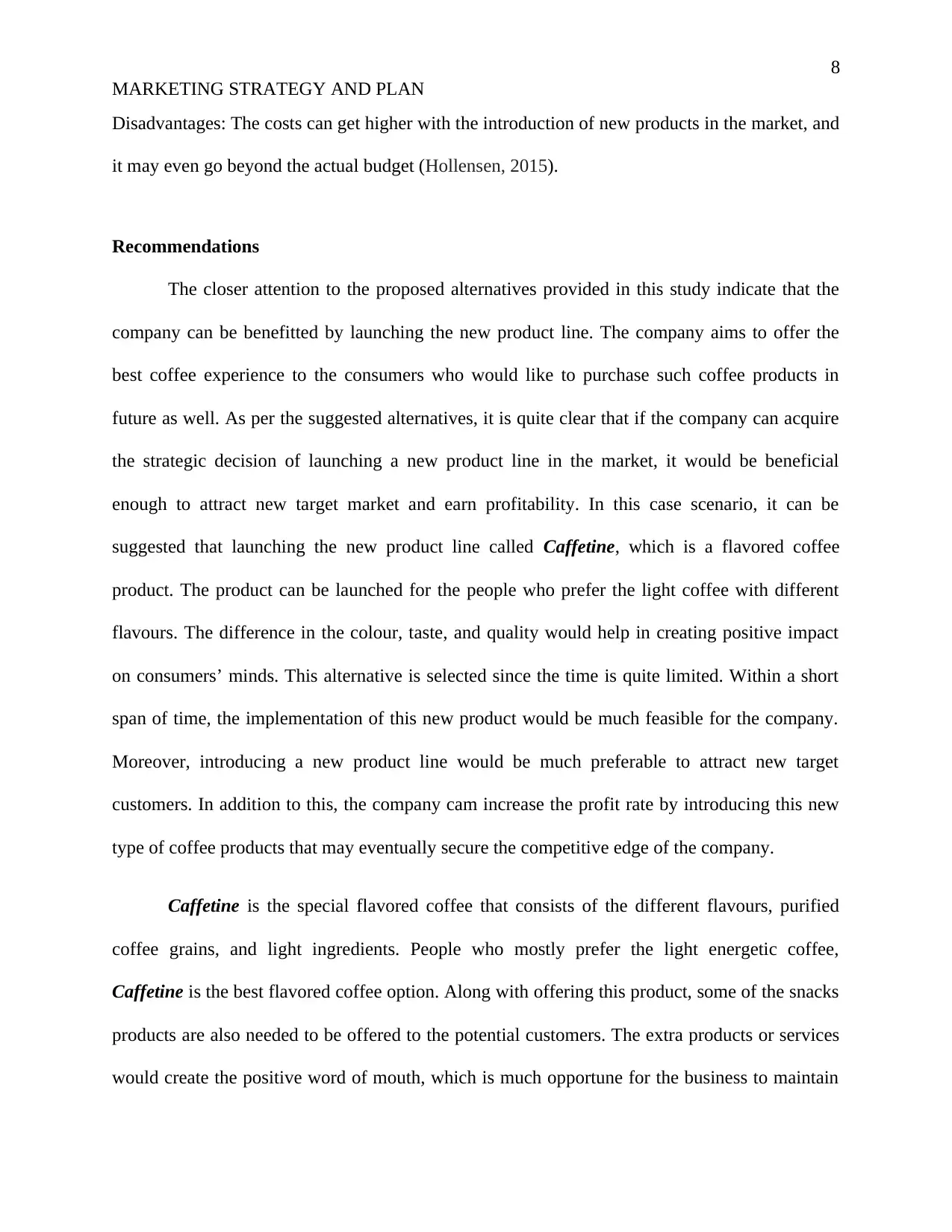
8
MARKETING STRATEGY AND PLAN
Disadvantages: The costs can get higher with the introduction of new products in the market, and
it may even go beyond the actual budget (Hollensen, 2015).
Recommendations
The closer attention to the proposed alternatives provided in this study indicate that the
company can be benefitted by launching the new product line. The company aims to offer the
best coffee experience to the consumers who would like to purchase such coffee products in
future as well. As per the suggested alternatives, it is quite clear that if the company can acquire
the strategic decision of launching a new product line in the market, it would be beneficial
enough to attract new target market and earn profitability. In this case scenario, it can be
suggested that launching the new product line called Caffetine, which is a flavored coffee
product. The product can be launched for the people who prefer the light coffee with different
flavours. The difference in the colour, taste, and quality would help in creating positive impact
on consumers’ minds. This alternative is selected since the time is quite limited. Within a short
span of time, the implementation of this new product would be much feasible for the company.
Moreover, introducing a new product line would be much preferable to attract new target
customers. In addition to this, the company cam increase the profit rate by introducing this new
type of coffee products that may eventually secure the competitive edge of the company.
Caffetine is the special flavored coffee that consists of the different flavours, purified
coffee grains, and light ingredients. People who mostly prefer the light energetic coffee,
Caffetine is the best flavored coffee option. Along with offering this product, some of the snacks
products are also needed to be offered to the potential customers. The extra products or services
would create the positive word of mouth, which is much opportune for the business to maintain
MARKETING STRATEGY AND PLAN
Disadvantages: The costs can get higher with the introduction of new products in the market, and
it may even go beyond the actual budget (Hollensen, 2015).
Recommendations
The closer attention to the proposed alternatives provided in this study indicate that the
company can be benefitted by launching the new product line. The company aims to offer the
best coffee experience to the consumers who would like to purchase such coffee products in
future as well. As per the suggested alternatives, it is quite clear that if the company can acquire
the strategic decision of launching a new product line in the market, it would be beneficial
enough to attract new target market and earn profitability. In this case scenario, it can be
suggested that launching the new product line called Caffetine, which is a flavored coffee
product. The product can be launched for the people who prefer the light coffee with different
flavours. The difference in the colour, taste, and quality would help in creating positive impact
on consumers’ minds. This alternative is selected since the time is quite limited. Within a short
span of time, the implementation of this new product would be much feasible for the company.
Moreover, introducing a new product line would be much preferable to attract new target
customers. In addition to this, the company cam increase the profit rate by introducing this new
type of coffee products that may eventually secure the competitive edge of the company.
Caffetine is the special flavored coffee that consists of the different flavours, purified
coffee grains, and light ingredients. People who mostly prefer the light energetic coffee,
Caffetine is the best flavored coffee option. Along with offering this product, some of the snacks
products are also needed to be offered to the potential customers. The extra products or services
would create the positive word of mouth, which is much opportune for the business to maintain
⊘ This is a preview!⊘
Do you want full access?
Subscribe today to unlock all pages.

Trusted by 1+ million students worldwide
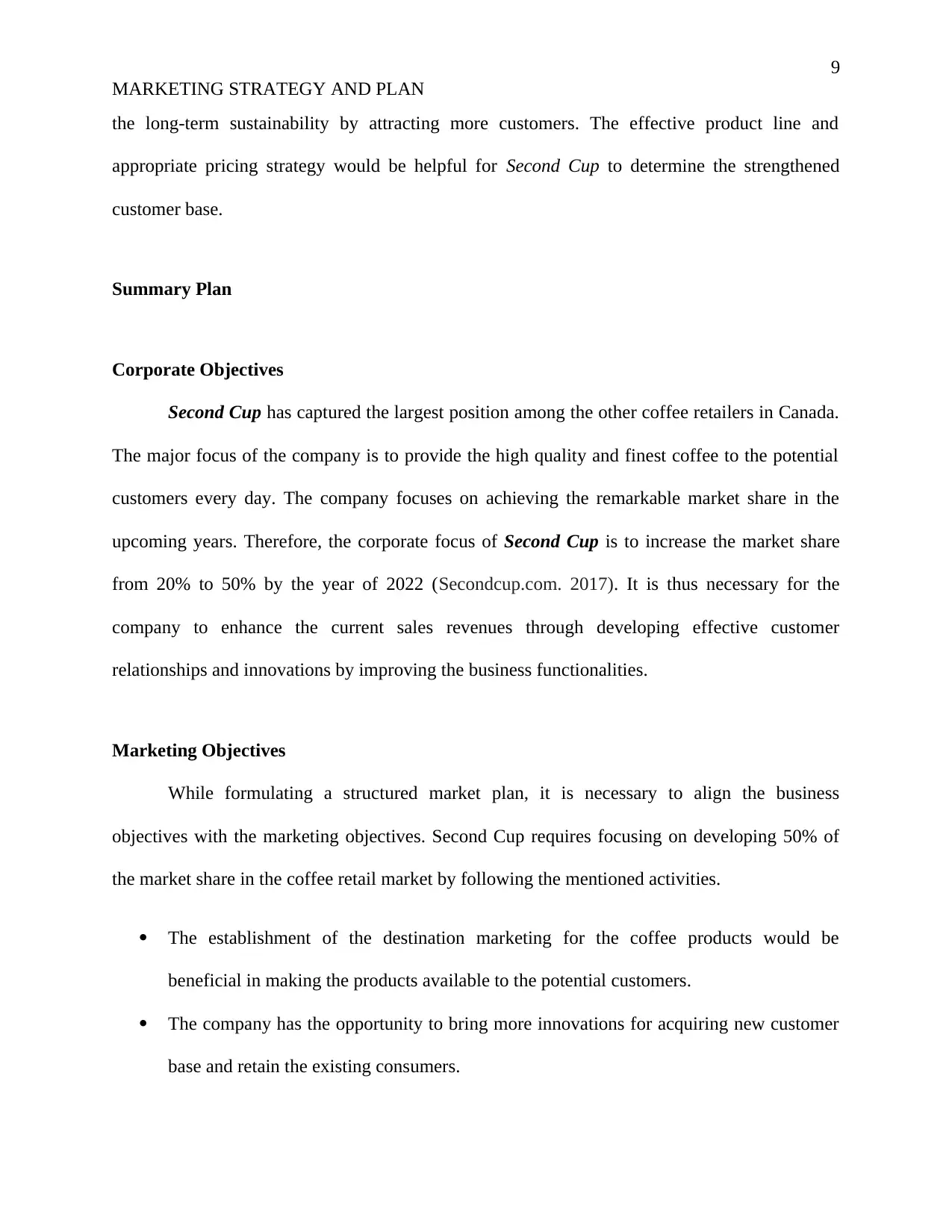
9
MARKETING STRATEGY AND PLAN
the long-term sustainability by attracting more customers. The effective product line and
appropriate pricing strategy would be helpful for Second Cup to determine the strengthened
customer base.
Summary Plan
Corporate Objectives
Second Cup has captured the largest position among the other coffee retailers in Canada.
The major focus of the company is to provide the high quality and finest coffee to the potential
customers every day. The company focuses on achieving the remarkable market share in the
upcoming years. Therefore, the corporate focus of Second Cup is to increase the market share
from 20% to 50% by the year of 2022 (Secondcup.com. 2017). It is thus necessary for the
company to enhance the current sales revenues through developing effective customer
relationships and innovations by improving the business functionalities.
Marketing Objectives
While formulating a structured market plan, it is necessary to align the business
objectives with the marketing objectives. Second Cup requires focusing on developing 50% of
the market share in the coffee retail market by following the mentioned activities.
The establishment of the destination marketing for the coffee products would be
beneficial in making the products available to the potential customers.
The company has the opportunity to bring more innovations for acquiring new customer
base and retain the existing consumers.
MARKETING STRATEGY AND PLAN
the long-term sustainability by attracting more customers. The effective product line and
appropriate pricing strategy would be helpful for Second Cup to determine the strengthened
customer base.
Summary Plan
Corporate Objectives
Second Cup has captured the largest position among the other coffee retailers in Canada.
The major focus of the company is to provide the high quality and finest coffee to the potential
customers every day. The company focuses on achieving the remarkable market share in the
upcoming years. Therefore, the corporate focus of Second Cup is to increase the market share
from 20% to 50% by the year of 2022 (Secondcup.com. 2017). It is thus necessary for the
company to enhance the current sales revenues through developing effective customer
relationships and innovations by improving the business functionalities.
Marketing Objectives
While formulating a structured market plan, it is necessary to align the business
objectives with the marketing objectives. Second Cup requires focusing on developing 50% of
the market share in the coffee retail market by following the mentioned activities.
The establishment of the destination marketing for the coffee products would be
beneficial in making the products available to the potential customers.
The company has the opportunity to bring more innovations for acquiring new customer
base and retain the existing consumers.
Paraphrase This Document
Need a fresh take? Get an instant paraphrase of this document with our AI Paraphraser
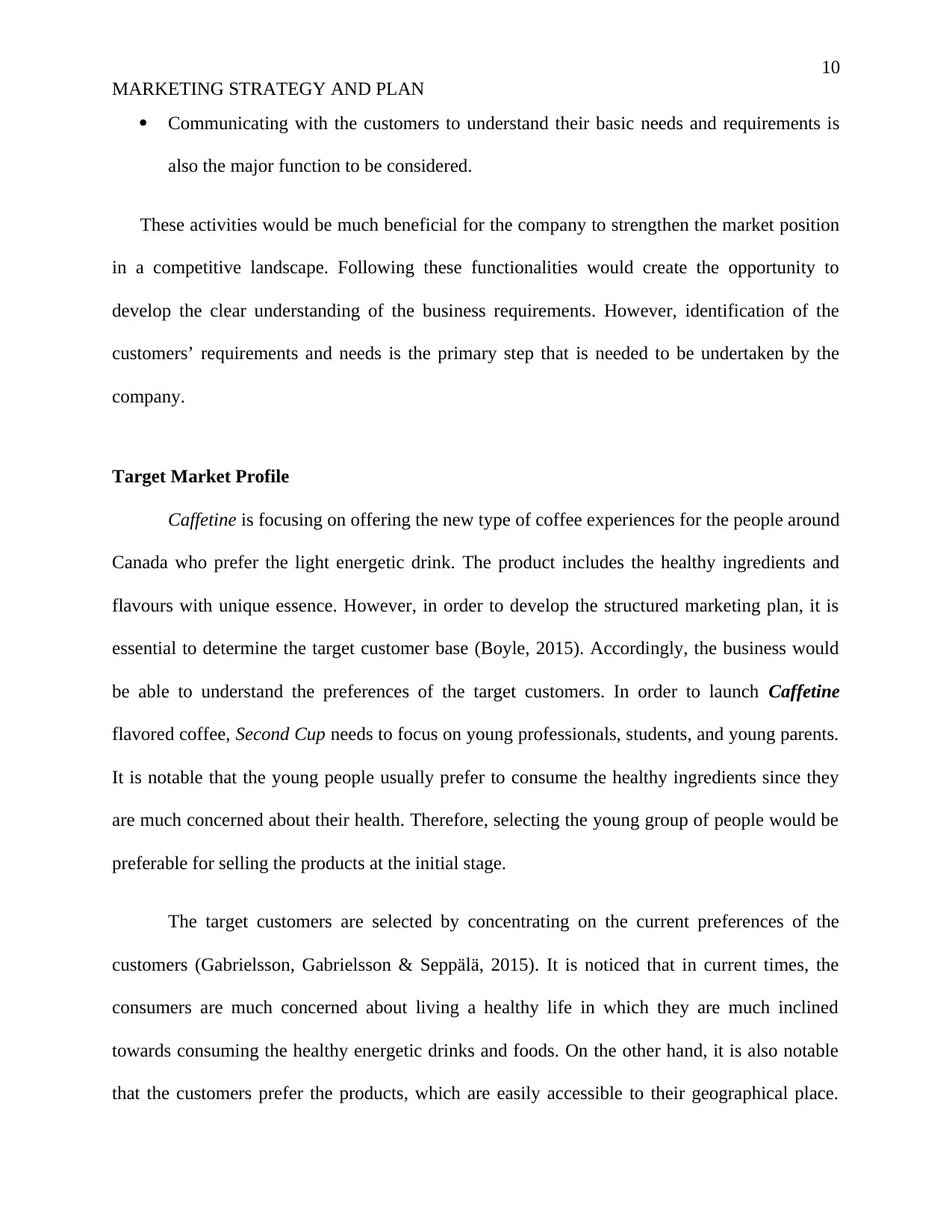
10
MARKETING STRATEGY AND PLAN
Communicating with the customers to understand their basic needs and requirements is
also the major function to be considered.
These activities would be much beneficial for the company to strengthen the market position
in a competitive landscape. Following these functionalities would create the opportunity to
develop the clear understanding of the business requirements. However, identification of the
customers’ requirements and needs is the primary step that is needed to be undertaken by the
company.
Target Market Profile
Caffetine is focusing on offering the new type of coffee experiences for the people around
Canada who prefer the light energetic drink. The product includes the healthy ingredients and
flavours with unique essence. However, in order to develop the structured marketing plan, it is
essential to determine the target customer base (Boyle, 2015). Accordingly, the business would
be able to understand the preferences of the target customers. In order to launch Caffetine
flavored coffee, Second Cup needs to focus on young professionals, students, and young parents.
It is notable that the young people usually prefer to consume the healthy ingredients since they
are much concerned about their health. Therefore, selecting the young group of people would be
preferable for selling the products at the initial stage.
The target customers are selected by concentrating on the current preferences of the
customers (Gabrielsson, Gabrielsson & Seppälä, 2015). It is noticed that in current times, the
consumers are much concerned about living a healthy life in which they are much inclined
towards consuming the healthy energetic drinks and foods. On the other hand, it is also notable
that the customers prefer the products, which are easily accessible to their geographical place.
MARKETING STRATEGY AND PLAN
Communicating with the customers to understand their basic needs and requirements is
also the major function to be considered.
These activities would be much beneficial for the company to strengthen the market position
in a competitive landscape. Following these functionalities would create the opportunity to
develop the clear understanding of the business requirements. However, identification of the
customers’ requirements and needs is the primary step that is needed to be undertaken by the
company.
Target Market Profile
Caffetine is focusing on offering the new type of coffee experiences for the people around
Canada who prefer the light energetic drink. The product includes the healthy ingredients and
flavours with unique essence. However, in order to develop the structured marketing plan, it is
essential to determine the target customer base (Boyle, 2015). Accordingly, the business would
be able to understand the preferences of the target customers. In order to launch Caffetine
flavored coffee, Second Cup needs to focus on young professionals, students, and young parents.
It is notable that the young people usually prefer to consume the healthy ingredients since they
are much concerned about their health. Therefore, selecting the young group of people would be
preferable for selling the products at the initial stage.
The target customers are selected by concentrating on the current preferences of the
customers (Gabrielsson, Gabrielsson & Seppälä, 2015). It is noticed that in current times, the
consumers are much concerned about living a healthy life in which they are much inclined
towards consuming the healthy energetic drinks and foods. On the other hand, it is also notable
that the customers prefer the products, which are easily accessible to their geographical place.
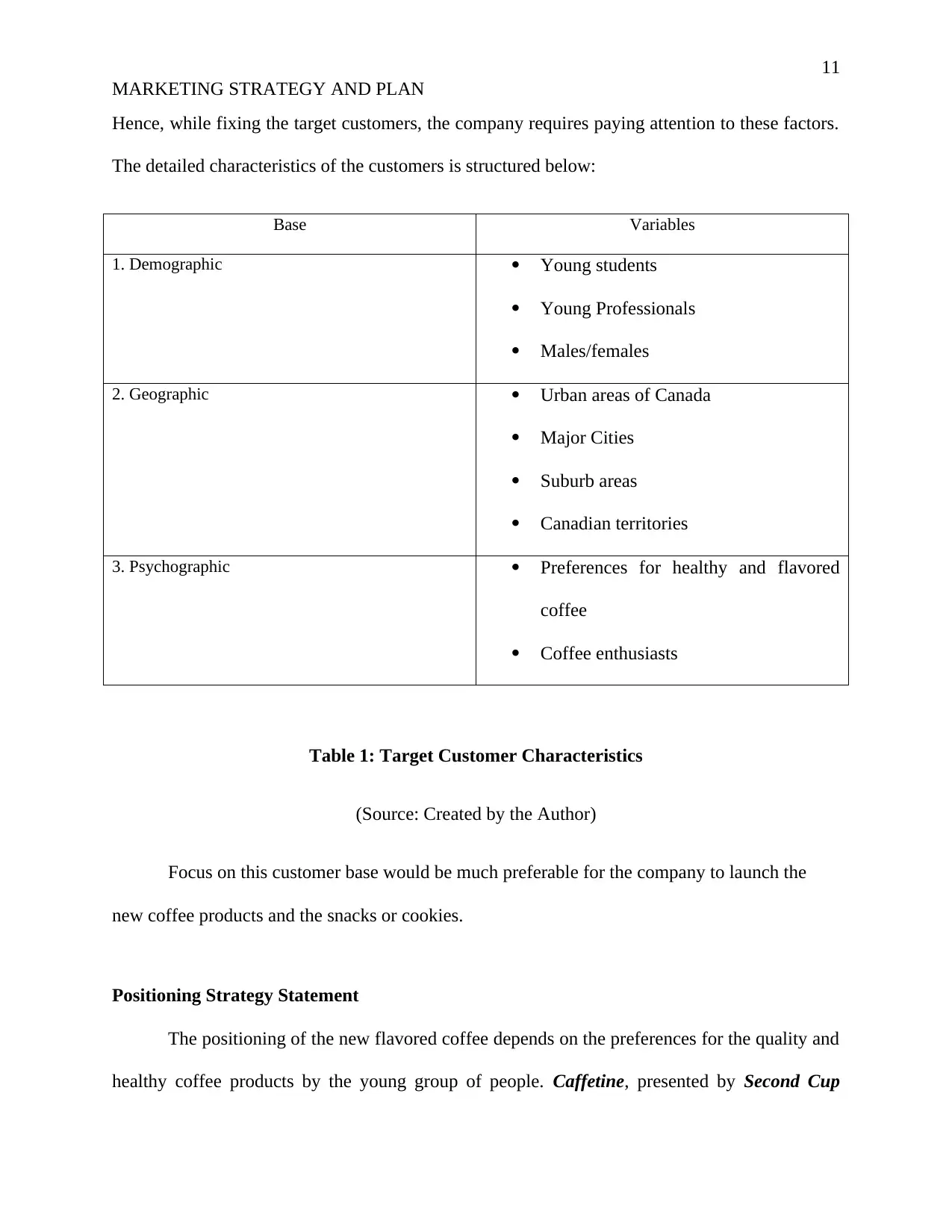
11
MARKETING STRATEGY AND PLAN
Hence, while fixing the target customers, the company requires paying attention to these factors.
The detailed characteristics of the customers is structured below:
Base Variables
1. Demographic Young students
Young Professionals
Males/females
2. Geographic Urban areas of Canada
Major Cities
Suburb areas
Canadian territories
3. Psychographic Preferences for healthy and flavored
coffee
Coffee enthusiasts
Table 1: Target Customer Characteristics
(Source: Created by the Author)
Focus on this customer base would be much preferable for the company to launch the
new coffee products and the snacks or cookies.
Positioning Strategy Statement
The positioning of the new flavored coffee depends on the preferences for the quality and
healthy coffee products by the young group of people. Caffetine, presented by Second Cup
MARKETING STRATEGY AND PLAN
Hence, while fixing the target customers, the company requires paying attention to these factors.
The detailed characteristics of the customers is structured below:
Base Variables
1. Demographic Young students
Young Professionals
Males/females
2. Geographic Urban areas of Canada
Major Cities
Suburb areas
Canadian territories
3. Psychographic Preferences for healthy and flavored
coffee
Coffee enthusiasts
Table 1: Target Customer Characteristics
(Source: Created by the Author)
Focus on this customer base would be much preferable for the company to launch the
new coffee products and the snacks or cookies.
Positioning Strategy Statement
The positioning of the new flavored coffee depends on the preferences for the quality and
healthy coffee products by the young group of people. Caffetine, presented by Second Cup
⊘ This is a preview!⊘
Do you want full access?
Subscribe today to unlock all pages.

Trusted by 1+ million students worldwide
1 out of 21
Related Documents
Your All-in-One AI-Powered Toolkit for Academic Success.
+13062052269
info@desklib.com
Available 24*7 on WhatsApp / Email
![[object Object]](/_next/static/media/star-bottom.7253800d.svg)
Unlock your academic potential
Copyright © 2020–2025 A2Z Services. All Rights Reserved. Developed and managed by ZUCOL.





